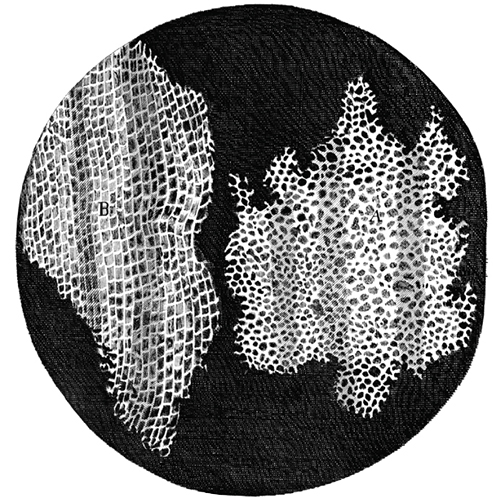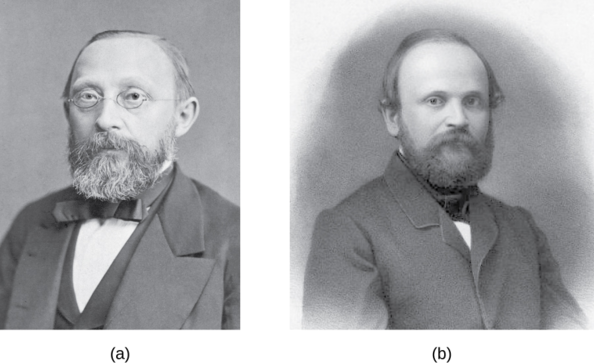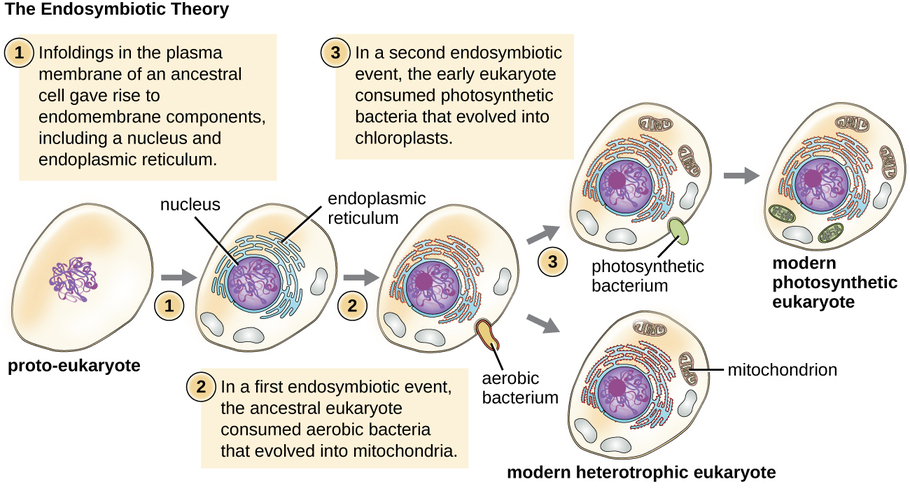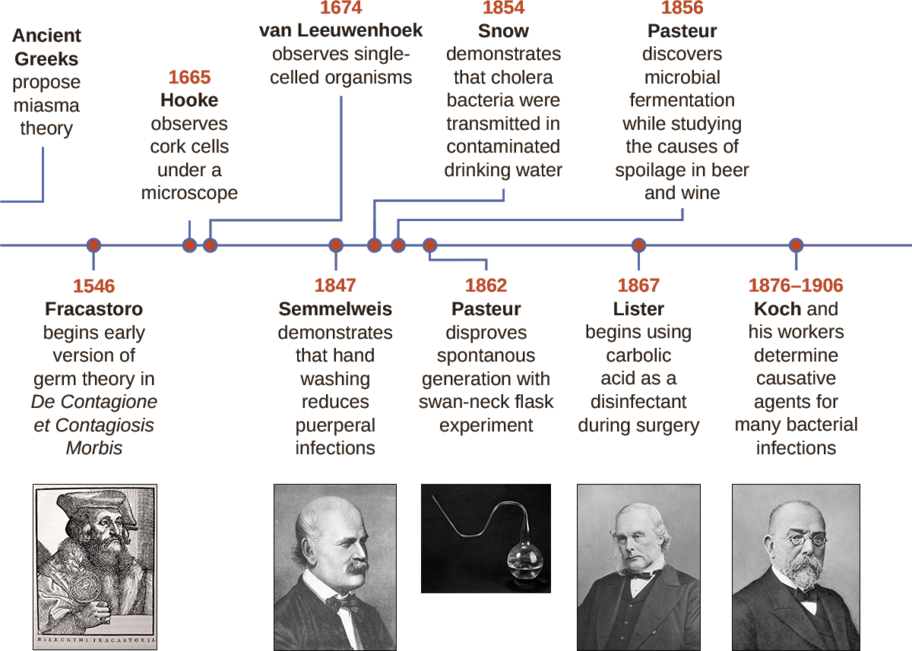2.1: Foundations of Modern Cell Theory
- Page ID
- 42472
Learning Objectives
- Explain the key points of cell theory and the individual contributions of Hooke, Schleiden, Schwann, Remak, and Virchow
- Explain the key points of endosymbiotic theory and cite the evidence that supports this concept
- Explain the contributions of Semmelweis, Snow, Pasteur, Lister, and Koch to the development of germ theory
While some scientists were arguing over the theory of spontaneous generation, other scientists were making discoveries leading to a better understanding of what we now call the cell theory. Modern cell theory has two basic tenets:
- All cells only come from other cells (the principle of biogenesis).
- Cells are the fundamental units of organisms.
Today, these tenets are fundamental to our understanding of life on earth. However, modern cell theory grew out of the collective work of many scientists.
The Origins of Cell Theory
The English scientist Robert Hooke first used the term “cells” in 1665 to describe the small chambers within cork that he observed under a microscope of his own design. To Hooke, thin sections of cork resembled “Honey-comb,” or “small Boxes or Bladders of Air.” He noted that each “Cavern, Bubble, or Cell” was distinct from the others (Figure \(\PageIndex{1}\)). At the time, Hooke was not aware that the cork cells were long dead and, therefore, lacked the internal structures found within living cells.

Despite Hooke’s early description of cells, their significance as the fundamental unit of life was not yet recognized. Nearly 200 years later, in 1838, Matthias Schleiden (1804–1881), a German botanist who made extensive microscopic observations of plant tissues, described them as being composed of cells. Visualizing plant cells was relatively easy because plant cells are clearly separated by their thick cell walls. Schleiden believed that cells formed through crystallization, rather than cell division.
Theodor Schwann (1810–1882), a noted German physiologist, made similar microscopic observations of animal tissue. In 1839, after a conversation with Schleiden, Schwann realized that similarities existed between plant and animal tissues. This laid the foundation for the idea that cells are the fundamental components of plants and animals.
In the 1850s, two Polish scientists living in Germany pushed this idea further, culminating in what we recognize today as the modern cell theory. In 1852, Robert Remak (1815–1865), a prominent neurologist and embryologist, published convincing evidence that cells are derived from other cells as a result of cell division. However, this idea was questioned by many in the scientific community. Three years later, Rudolf Virchow (1821–1902), a well-respected pathologist, published an editorial essay entitled “Cellular Pathology,” which popularized the concept of cell theory using the Latin phrase omnis cellula a cellula (“all cells arise from cells”), which is essentially the second tenet of modern cell theory.1Given the similarity of Virchow’s work to Remak’s, there is some controversy as to which scientist should receive credit for articulating cell theory. See the following Eye on Ethics feature for more about this controversy.
SCIENCE AND PLAGIARISM
Rudolf Virchow, a prominent, Polish-born, German scientist, is often remembered as the “Father of Pathology.” Well known for innovative approaches, he was one of the first to determine the causes of various diseases by examining their effects on tissues and organs. He was also among the first to use animals in his research and, as a result of his work, he was the first to name numerous diseases and created many other medical terms. Over the course of his career, he published more than 2,000 papers and headed various important medical facilities, including the Charité – Universitätsmedizin Berlin, a prominent Berlin hospital and medical school. But he is, perhaps, best remembered for his 1855 editorial essay titled “Cellular Pathology,” published in Archiv für Pathologische Anatomie und Physiologie, a journal that Virchow himself cofounded and still exists today.
Despite his significant scientific legacy, there is some controversy regarding this essay, in which Virchow proposed the central tenet of modern cell theory—that all cells arise from other cells. Robert Remak, a former colleague who worked in the same laboratory as Virchow at the University of Berlin, had published the same idea 3 years before. Though it appears Virchow was familiar with Remak’s work, he neglected to credit Remak’s ideas in his essay. When Remak wrote a letter to Virchow pointing out similarities between Virchow’s ideas and his own, Virchow was dismissive. In 1858, in the preface to one of his books, Virchow wrote that his 1855 publication was just an editorial piece, not a scientific paper, and thus there was no need to cite Remak’s work.

By today’s standards, Virchow’s editorial piece would certainly be considered an act of plagiarism, since he presented Remak’s ideas as his own. However, in the 19th century, standards for academic integrity were much less clear. Virchow’s strong reputation, coupled with the fact that Remak was a Jew in a somewhat anti-Semitic political climate, shielded him from any significant repercussions. Today, the process of peer review and the ease of access to the scientific literature help discourage plagiarism. Although scientists are still motivated to publish original ideas that advance scientific knowledge, those who would consider plagiarizing are well aware of the serious consequences.
In academia, plagiarism represents the theft of both individual thought and research—an offense that can destroy reputations and end careers.2 3 4 5
Exercise \(\PageIndex{1}\)
- What are the key points of the cell theory?
- What contributions did Rudolf Virchow and Robert Remak make to the development of the cell theory?
Endosymbiotic Theory
As scientists were making progress toward understanding the role of cells in plant and animal tissues, others were examining the structures within the cells themselves. In 1831, Scottish botanist Robert Brown (1773–1858) was the first to describe observations of nuclei, which he observed in plant cells. Then, in the early 1880s, German botanist Andreas Schimper (1856–1901) was the first to describe the chloroplasts of plant cells, identifying their role in starch formation during photosynthesis and noting that they divided independent of the nucleus.
Based upon the chloroplasts’ ability to reproduce independently, Russian botanist Konstantin Mereschkowski (1855–1921) suggested in 1905 that chloroplasts may have originated from ancestral photosynthetic bacteria living symbiotically inside a eukaryotic cell. He proposed a similar origin for the nucleus of plant cells. This was the first articulation of the endosymbiotic hypothesis, and would explain how eukaryotic cells evolved from ancestral bacteria.
Mereschkowski’s endosymbiotic hypothesis was furthered by American anatomist Ivan Wallin (1883–1969), who began to experimentally examine the similarities between mitochondria, chloroplasts, and bacteria—in other words, to put the endosymbiotic hypothesis to the test using objective investigation. Wallin published a series of papers in the 1920s supporting the endosymbiotic hypothesis, including a 1926 publication co-authored with Mereschkowski. Wallin claimed he could culture mitochondria outside of their eukaryotic host cells. Many scientists dismissed his cultures of mitochondria as resulting from bacterial contamination. Modern genome sequencing work supports the dissenting scientists by showing that much of the genome of mitochondria had been transferred to the host cell’s nucleus, preventing the mitochondria from being able to live on their own.6 7
Wallin’s ideas regarding the endosymbiotic hypothesis were largely ignored for the next 50 years because scientists were unaware that these organelles contained their own DNA. However, with the discovery of mitochondrial and chloroplast DNA in the 1960s, the endosymbiotic hypothesis was resurrected. Lynn Margulis (1938–2011), an American geneticist, published her ideas regarding the endosymbiotic hypothesis of the origins of mitochondria and chloroplasts in 1967.8 In the decade leading up to her publication, advances in microscopy had allowed scientists to differentiate prokaryotic cells from eukaryotic cells. In her publication, Margulis reviewed the literature and argued that the eukaryotic organelles such as mitochondria and chloroplasts are of prokaryotic origin. She presented a growing body of microscopic, genetic, molecular biology, fossil, and geological data to support her claims.
Again, this hypothesis was not initially popular, but mounting genetic evidence due to the advent of DNA sequencing supported the endosymbiotic theory, which is now defined as the theory that mitochondria and chloroplasts arose as a result of prokaryotic cells establishing a symbiotic relationship within a eukaryotic host (Figure \(\PageIndex{3}\)). With Margulis’ initial endosymbiotic theory gaining wide acceptance, she expanded on the theory in her 1981 book Symbiosis in Cell Evolution. In it, she explains how endosymbiosis is a major driving factor in the evolution of organisms. More recent genetic sequencing and phylogenetic analysis show that mitochondrial DNA and chloroplast DNA are highly related to their bacterial counterparts, both in DNA sequence and chromosome structure. However, mitochondrial DNA and chloroplast DNA are reduced compared with nuclear DNA because many of the genes have moved from the organelles into the host cell’s nucleus. Additionally, mitochondrial and chloroplast ribosomes are structurally similar to bacterial ribosomes, rather than to the eukaryotic ribosomes of their hosts. Last, the binary fission of these organelles strongly resembles the binary fission of bacteria, as compared with mitosis performed by eukaryotic cells. Since Margulis’ original proposal, scientists have observed several examples of bacterial endosymbionts in modern-day eukaryotic cells. Examples include the endosymbiotic bacteria found within the guts of certain insects, such as cockroaches,9 and photosynthetic bacteria-like organelles found in protists.10

Exercise \(\PageIndex{2}\)
- What does the modern endosymbiotic theory state?
- What evidence supports the endosymbiotic theory?

Key Concepts and Summary
- Although cells were first observed in the 1660s by Robert Hooke, cell theory was not well accepted for another 200 years. The work of scientists such as Schleiden, Schwann, Remak, and Virchow contributed to its acceptance.
- Endosymbiotic theory states that mitochondria and chloroplasts, organelles found in many types of organisms, have their origins in bacteria. Significant structural and genetic information support this theory.
Footnotes
- 1 M. Schultz. “Rudolph Virchow.” Emerging Infectious Diseases 14 no. 9 (2008):1480–1481.
- 2 B. Kisch. “Forgotten Leaders in Modern Medicine, Valentin, Gouby, Remak, Auerbach.” Transactions of the American Philosophical Society 44 (1954):139–317.
- 3 H. Harris. The Birth of the Cell. New Haven, CT: Yale University Press, 2000:133.
- 4 C. Webster (ed.). Biology, Medicine and Society 1840-1940. Cambridge, UK; Cambridge University Press, 1981:118–119.
- 5 C. Zuchora-Walske. Key Discoveries in Life Science. Minneapolis, MN: Lerner Publishing, 2015:12–13.
- 6 T. Embley, W. Martin. “Eukaryotic Evolution, Changes, and Challenges.” Nature Vol. 440 (2006):623–630.
- 7 O.G. Berg, C.G. Kurland. “Why Mitochondrial Genes Are Most Often Found in Nuclei.” Molecular Biology and Evolution 17 no. 6 (2000):951–961.
- 8 L. Sagan. “On the Origin of Mitosing Cells.” Journal of Theoretical Biology 14 no. 3 (1967):225–274.
- 9 A.E. Douglas. “The Microbial Dimension in Insect Nutritional Ecology.” Functional Ecology 23 (2009):38–47.
- 10 J.M. Jaynes, L.P. Vernon. “The Cyanelle of Cyanophora paradoxa: Almost a Cyanobacterial Chloroplast.” Trends in Biochemical Sciences 7 no. 1 (1982):22–24.
- 11 Alexander, J. Wesley. “The Contributions of Infection Control to a Century of Progress” Annals of Surgery 201:423-428, 1985.
Contributor
Nina Parker, (Shenandoah University), Mark Schneegurt (Wichita State University), Anh-Hue Thi Tu (Georgia Southwestern State University), Philip Lister (Central New Mexico Community College), and Brian M. Forster (Saint Joseph’s University) with many contributing authors. Original content via Openstax (CC BY 4.0; Access for free at https://openstax.org/books/microbiology/pages/1-introduction)


